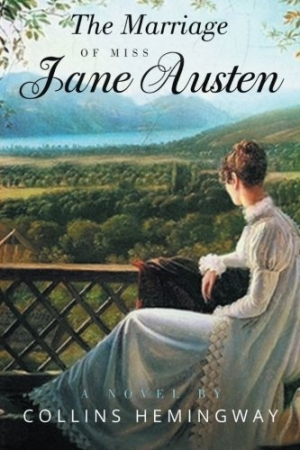The Marriage of Miss Jane Austen
Insight and intuition, along with meticulous research, have created a believable “what if” version of Jane Austen.
A skillful portrayal of an early nineteenth-century literary icon takes this historical romance on an imaginative journey of the soul. The Marriage of Miss Jane Austen, by Collins Hemingway, reinvents the life of this renowned author, imagining the course of events if she had met the man of her dreams.
Pondering, polite, and reflective, this heartfelt novel delves into the hypothetical. Every Austen fan would like to know what would have happened if she had wed. How would this intelligent writer have reacted to the intrusion of a husband? Or responded to the obligations associated with wealth? No one can know for certain, even though her views on love were evident in her work. Insight and intuition, along with meticulous research, have created a believable version of her character in this tender story of Ashton and Jane. Opinionated family members, as well as the restraints of staid English society, interfere with the progression of this conflicted yet presumably ideal match. Eager and emotional, Ashton cannot accept Jane’s mature resistance, leading to long-term separation midway through the plot when he departs for the West Indies in pursuit of goals other than winning her hand.
A quarter of the book is an epistolary novel—an exchange of letters that “tells” rather than shows the sequence of events. Though interesting to an aficionado of the era, the pace slows and the movement seems delayed, bogging the pages down with a prolonged stall. The tendency is to skim rather than scrutinize, and this may lead to less of a dramatic impact than intended. Sophisticated use of language maintains the realism, yet preoccupation with the words themselves may detract from advancement of the plot.
Excellent character development enhances the plausibility of the scenario. Background, motivation, eccentricity—everything that constitutes a personality allow these fascinating people to step off the pages in lifelike form. Bright, colorful descriptive passages establish a sense of place, building atmosphere and mood.
In a tense scene with Ashton, Jane reacts with surprise to his proposal:
She felt as if she had been suddenly plunged underwater. Her head roared; it seemed that all sound had been extinguished. Yet she could hear the clatter in the kitchen two rooms away, and the comfortable murmuring of staff who had worked there together for years. It was the immediate vicinity that was murky and confused and that made her fear to breathe.
Passionate about “creative investigation,” Collins Hemingway plans a sequel to The Marriage of Miss Jane Austen in which he will explore Jane’s new marriage and the problems that ensue. Inspired by this Regency writer, Hemingway immerses himself in her unique world—a stylistic tribute that evokes the genteel atmosphere of the period.
Reviewed by
Julia Ann Charpentier
Disclosure: This article is not an endorsement, but a review. The publisher of this book provided free copies of the book and paid a small fee to have their book reviewed by a professional reviewer. Foreword Reviews and Clarion Reviews make no guarantee that the publisher will receive a positive review. Foreword Magazine, Inc. is disclosing this in accordance with the Federal Trade Commission’s 16 CFR, Part 255.

